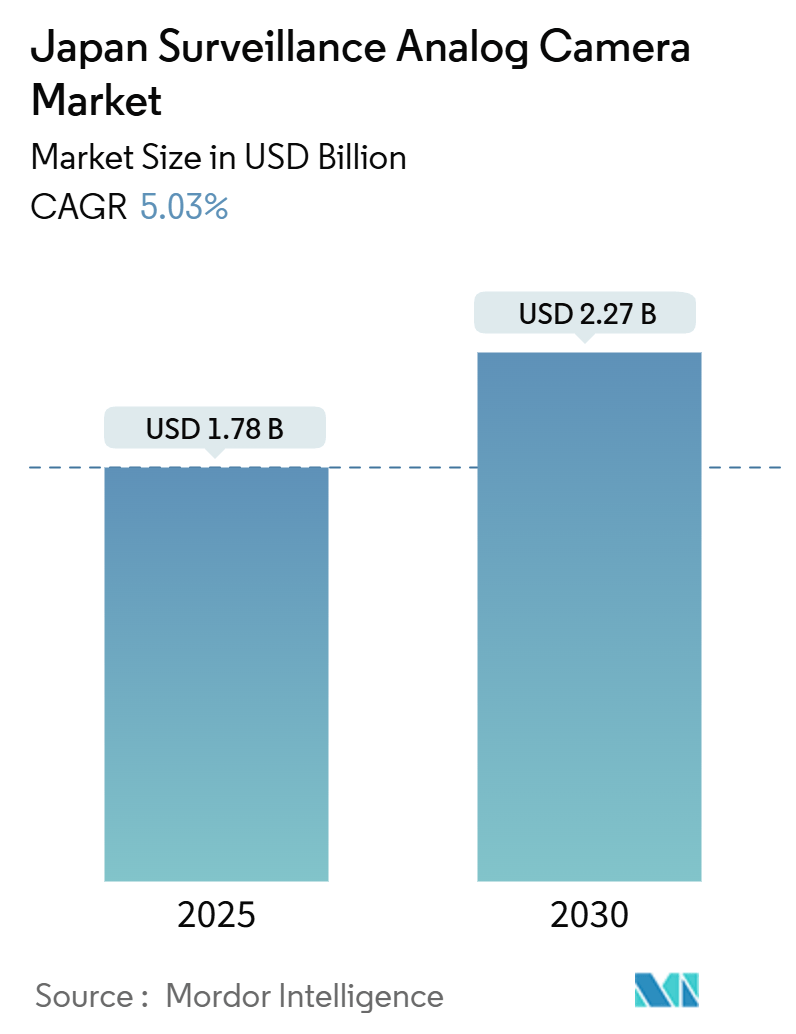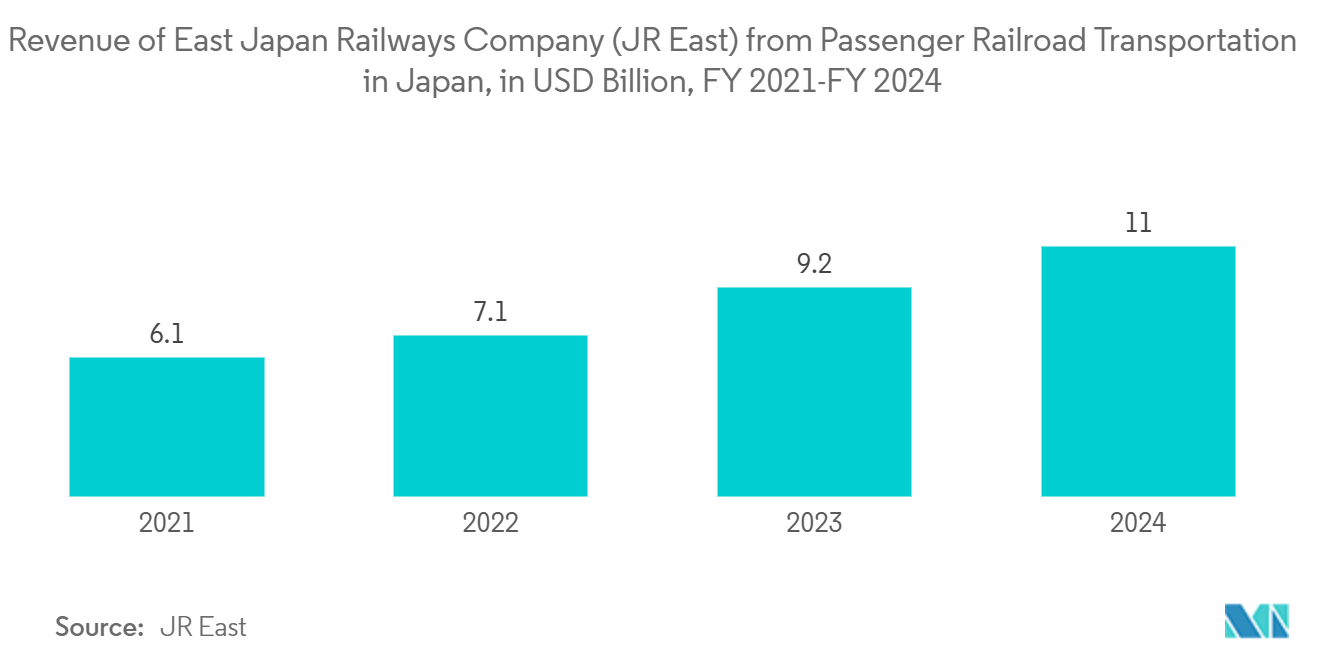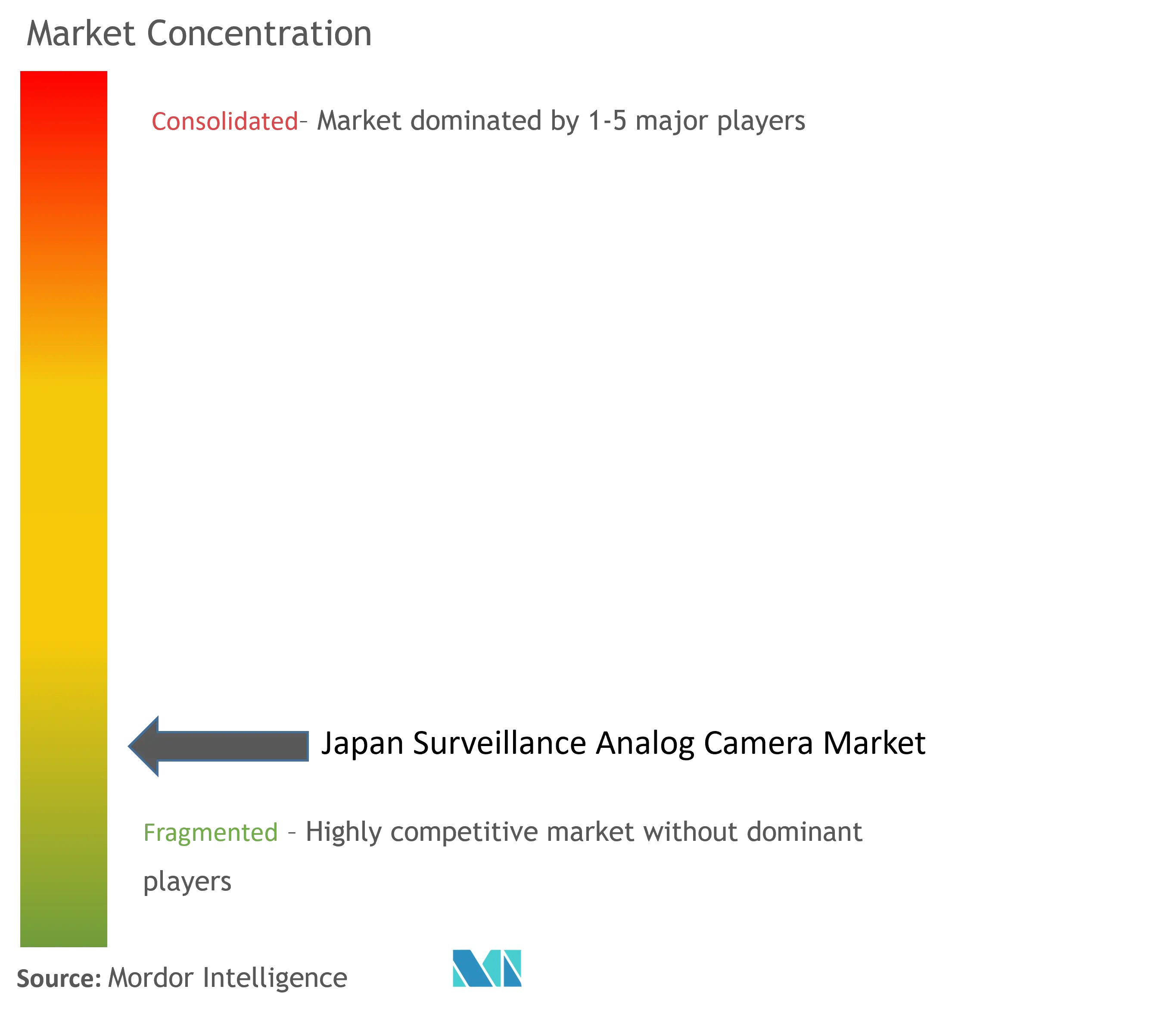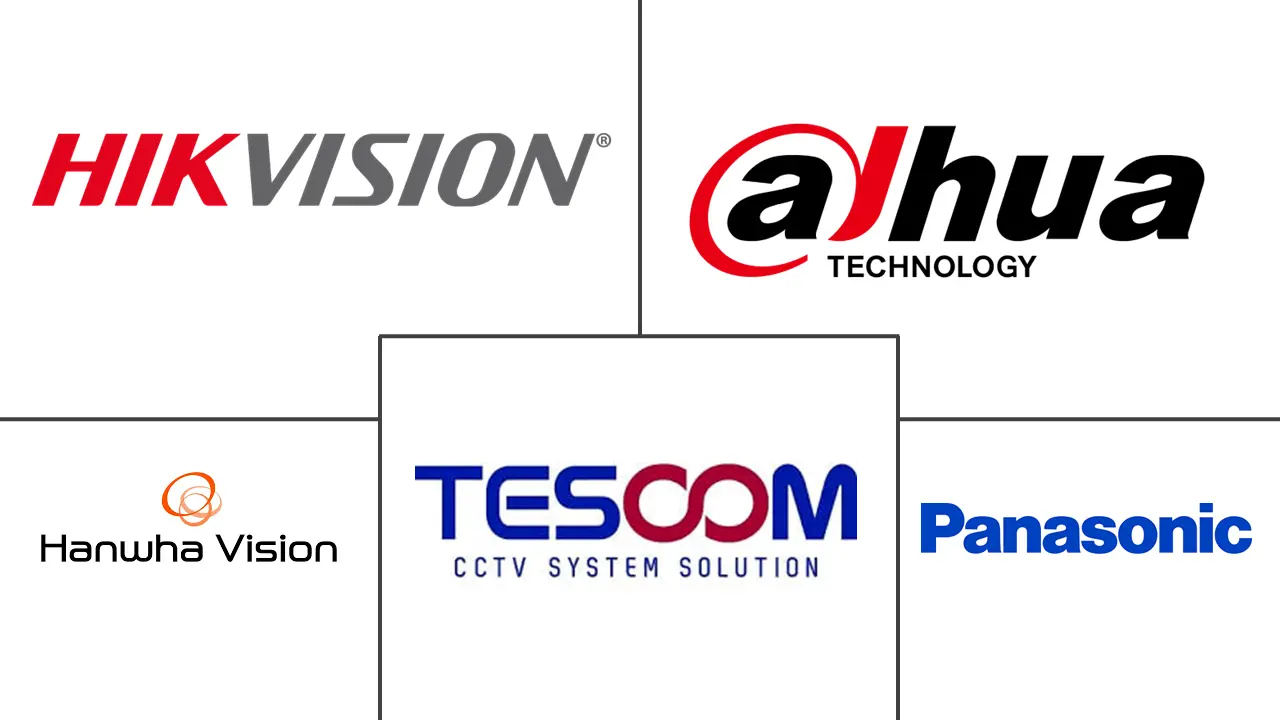Japan Surveillance Analog Camera Market Size and Share

Japan Surveillance Analog Camera Market Analysis by Mordor Intelligence
The Japan Surveillance Analog Camera Market size is estimated at USD 1.78 billion in 2025, and is expected to reach USD 2.27 billion by 2030, at a CAGR of 5.03% during the forecast period (2025-2030).
- Analog surveillance cameras are generally more cost-effective to purchase, install, and maintain than digital IP-based systems. This cost advantage is significant for large-scale deployments, where organizations must balance security requirements with budgetary constraints. Analog cameras can seamlessly integrate with existing analog-based video management systems, reducing the need for costly infrastructure overhauls.
- Many of Japan's existing surveillance systems were installed decades ago and are based on analog camera technologies. As these legacy systems reach the end of their lifespan, there is a significant need to replace and upgrade them to maintain adequate security and monitoring capabilities. Analog cameras are often seen as a familiar and reliable replacement option, as they can be easily integrated with the existing infrastructure and require minimal personnel retraining.
- Japan's geographical location and climate expose its infrastructure to various natural disasters, including earthquakes, typhoons, and heavy snowfall. Analog cameras are renowned for their rugged construction and ability to endure harsh environmental conditions, making them a preferred choice for mission-critical security applications. The reliable performance of analog systems, even during power outages or network disruptions, is a key factor driving their adoption in Japan.
- However, such cameras frequently encounter scalability challenges, making it complex and costly to expand the number of cameras or integrate them with other systems. The absence of standardized protocols and interoperability between analog and digital systems further complicates seamless integration, limiting the flexibility of analog surveillance networks.
- Japan's ongoing economic expansion and swift urbanization drive heightened infrastructure investments, notably in bolstering the surveillance industry. This persistent need for security solutions propels the surveillance camera market, encompassing analog cameras. The International Monetary Fund (IMF) projects Japan's GDP to rise from USD 4,212.94 billion in 2023 to USD 4,944.74 billion by 2029. This growth is bolstered by the nation's strong economy, which bodes well for the market studied.
Japan Surveillance Analog Camera Market Trends and Insights
Cost-Effectiveness of Analog Cameras is Expected to Drive the Market Growth
- Analog cameras typically have a lower base price than their digital IP-based counterparts. This can be a significant advantage for organizations with limited budgets or those looking to expand their surveillance coverage across multiple sites. The lower initial investment makes analog cameras more accessible, especially for small and medium-sized businesses or public-sector entities. In addition, as per the Ministry of Finance Japan, in fiscal year 2023, the Japanese national government allocated an initial budget of around JPY 170 billion (~USD 1.2 billion) for promoting small- and medium-sized businesses (SMBs).
- Analog cameras generally require less complex and less expensive infrastructure than IP-based systems. Analog cameras can often be easily integrated into existing coaxial cable-based networks, which are still widely used in Japan. Organizations can avoid costly network infrastructure upgrades, such as installing new Ethernet cabling or network switches. The more straightforward installation process for analog cameras reduces labor costs and project timelines.
- Analog cameras boast enhanced durability, with fewer moving parts, necessitating less frequent maintenance and repairs. Maintaining analog systems is simpler and more cost-effective, demanding fewer specialized technicians and resources. Moreover, analog cameras exhibit lower power consumption, translating to reduced energy expenditures for organizations.
- The cost efficiency of analog cameras empowers organizations to upgrade their surveillance setups gradually. Rather than opting for a complete and expensive overhaul, organizations can systematically integrate or replace analog cameras within their current framework. This phased strategy allows for a more manageable financial outlay, enabling organizations to bolster their surveillance capabilities.

Transportation and Logistics End-User Industry is Expected to Hold a Significant Market Share
- Japan's transportation and logistics network is extensive and geographically dispersed, encompassing highways, railways, ports, airports, warehouses, and distribution centers. East Japan Railways Company (JR East) also saw its revenue from passenger railway transportation in Japan reach around JPY 1.68 trillion (~USD 10.7 billion) in FY 2024, marking an increase from FY 2023. Monitoring and securing this vast infrastructure requires a large-scale surveillance system that can be cost-effectively deployed using analog cameras. Analog cameras enable organizations to cover a wider area with a lower overall investment.
- Many transportation and logistics facilities, such as outdoor storage yards, loading docks, and open-air terminals, are exposed to harsh environmental conditions. These include extreme temperatures, high humidity, dust, and other factors that can adversely impact the performance and reliability of electronic equipment. Analog cameras are generally more resilient and better equipped to withstand these challenging environmental conditions, offering superior durability and longevity.
- Several transportation and logistics firms in Japan have heavily invested in analog cameras deeply woven into their infrastructure. Swapping these analog setups for modern IP-based solutions proves intricate and expensive. It typically demands substantial network overhauls and intricate system integrations. Opting for analog cameras presents a more gradual, cost-efficient path. This approach facilitates seamless integration with the current infrastructure, allowing organizations to maximize their prior investments.
- The transportation and logistics sector prioritizes cost efficiency, striving to streamline operations and stay competitive. With lower initial costs, analog cameras appeal to budget-conscious organizations in this industry. Moreover, the decreased infrastructure and maintenance expenses further bolster the cost-effectiveness of analog cameras, a pivotal factor for transportation and logistics players.

Competitive Landscape
Japan's surveillance analog camera market is highly fragmented, with local and global players vying for market dominance. Major players channel resources into R&D to drive innovation alongside strategic moves such as partnerships, mergers, and acquisitions to bolster their competitive edge. Notable market participants include Hangzhou Hikvision Digital Technology Co. Ltd, Dahua Technology Co. Ltd, CP PLUS, Zhejiang Uniview Technologies Co. Ltd, and Shenzhen Sunell Technology Corporation.
- October 2023: Hikvision's move came with introducing the industry's first 2 MP analog cameras, featuring an impressive F1.0 aperture. This milestone was celebrated with the launch of their ColorVu Fixed Turret (DS-2CE70DF0T-MF) and Bullet (DS-2CE10DF0T-F) Cameras. These cameras offer superior full-color imaging round the clock and support HD over analog cabling for convenient upgrades. Additionally, they come equipped with advanced features like 3D Digital Noise Reduction (DNR) technology and an exceptional white light range.
- July 2023: Dahua Technology marked a decade of analog technology evolution with the release of HDCVI 2023. This latest iteration introduced global customers to AI-powered Over-Coax technology. HDCVI, short for High Definition Composite Video Interface, sets the standard for long-distance HD transmission, reaching up to 1,200 meters for audio, video, data, and power signals—all through a single coaxial cable connecting the camera and XVR. HDCVI 2023 elevates the game with a suite of intelligent functions, streamlining HD monitoring for installers and end-users without extra configurations.
Japan Surveillance Analog Camera Industry Leaders
-
Dahua Technology Co., Ltd.
-
Hangzhou Hikvision Digital Technology Co., Ltd.
-
Hanwha Vision Co., Ltd.
-
TESCOM JAPAN CO.,Ltd.
-
Panasonic Holdings Corporation
- *Disclaimer: Major Players sorted in no particular order

Recent Industry Developments
- April 2024: Hikvision unveiled its latest Turbo HD analog security line, Turbo HD 8.0, to elevate user security experiences. The upgraded version boasts four notable enhancements: real-time communication, 180-degree video coverage, improved night vision, and an expanded product portfolio. Noteworthy features include two-way audio, compact dual-lens cameras with stitching technology, and Smart Hybrid Light functionality integrated into the entire Turbo HD camera range. The release also showcases a new cutting-edge pro-series DVR, highlighting AcuSense technology.
- February 2024: The National Police Agency in Ishikawa Prefecture was set to deploy approximately 1,000 security cameras across evacuation centers and critical locations. This move aims to curb crimes, notably sexual assaults and break-ins, particularly in unoccupied residences. The agency also initiated live webcasts of patrol car footage, reassuring displaced residents after the Noto Peninsula Earthquake.
Japan Surveillance Analog Camera Market Report Scope
Analog cameras are employed in legacy surveillance systems. They are known to capture non-digital video streams and transmit them to Digital Video Recorders (DVRs) or video management systems (VMSs), typically over coaxial cables, for monitoring, storage, and analysis. The analysis measures the market size by evaluating sales of surveillance analog camera products in diverse end-user industries. The study explores growth trends and examines macroeconomic factors shaping the market.
The Japanese surveillance analog camera market is segmented by end-user industry (government, banking, healthcare, transportation, and logistics, industrial, and others [education institutions, retail, and enterprises]). The report provides market forecasts and size in value (USD) for all the above segments.
| Government |
| Banking |
| Healthcare |
| Transportation and Logistics |
| Industrial |
| Others (Education Institutions, Retail, and Enterprises) |
| By End-User Industry | Government |
| Banking | |
| Healthcare | |
| Transportation and Logistics | |
| Industrial | |
| Others (Education Institutions, Retail, and Enterprises) |
Key Questions Answered in the Report
How big is the Japan Surveillance Analog Camera Market?
The Japan Surveillance Analog Camera Market size is expected to reach USD 1.78 billion in 2025 and grow at a CAGR of 5.03% to reach USD 2.27 billion by 2030.
What is the current Japan Surveillance Analog Camera Market size?
In 2025, the Japan Surveillance Analog Camera Market size is expected to reach USD 1.78 billion.
Who are the key players in Japan Surveillance Analog Camera Market?
Dahua Technology Co., Ltd., Hangzhou Hikvision Digital Technology Co., Ltd., Hanwha Vision Co., Ltd., TESCOM JAPAN CO.,Ltd. and Panasonic Holdings Corporation are the major companies operating in the Japan Surveillance Analog Camera Market.
What years does this Japan Surveillance Analog Camera Market cover, and what was the market size in 2024?
In 2024, the Japan Surveillance Analog Camera Market size was estimated at USD 1.69 billion. The report covers the Japan Surveillance Analog Camera Market historical market size for years: 2019, 2020, 2021, 2022, 2023 and 2024. The report also forecasts the Japan Surveillance Analog Camera Market size for years: 2025, 2026, 2027, 2028, 2029 and 2030.
Page last updated on:
Japan Surveillance Analog Camera Market Report
Statistics for the 2025 Japan Surveillance Analog Camera market share, size and revenue growth rate, created by Mordor Intelligence™ Industry Reports. Japan Surveillance Analog Camera analysis includes a market forecast outlook for 2025 to 2030 and historical overview. Get a sample of this industry analysis as a free report PDF download.



